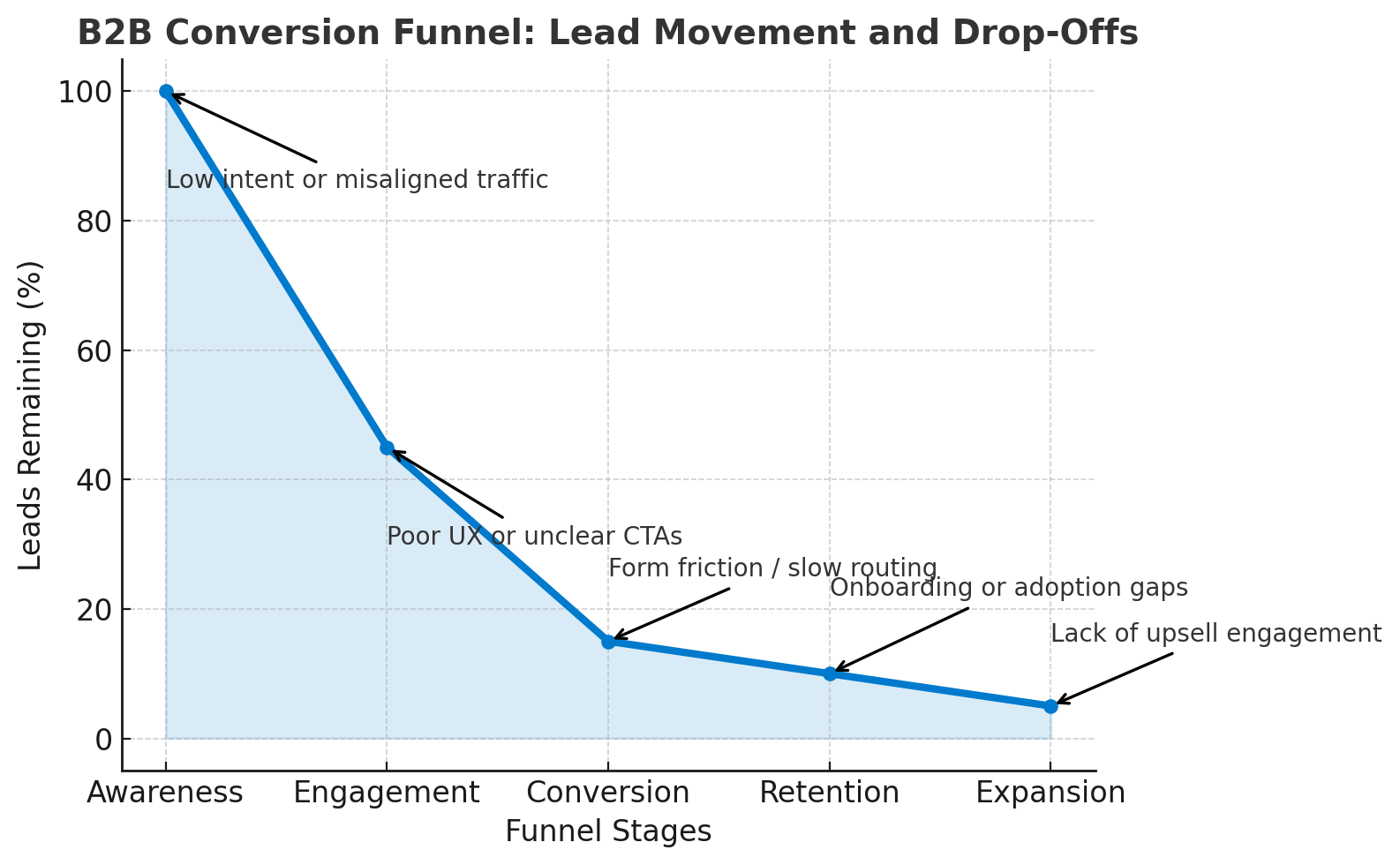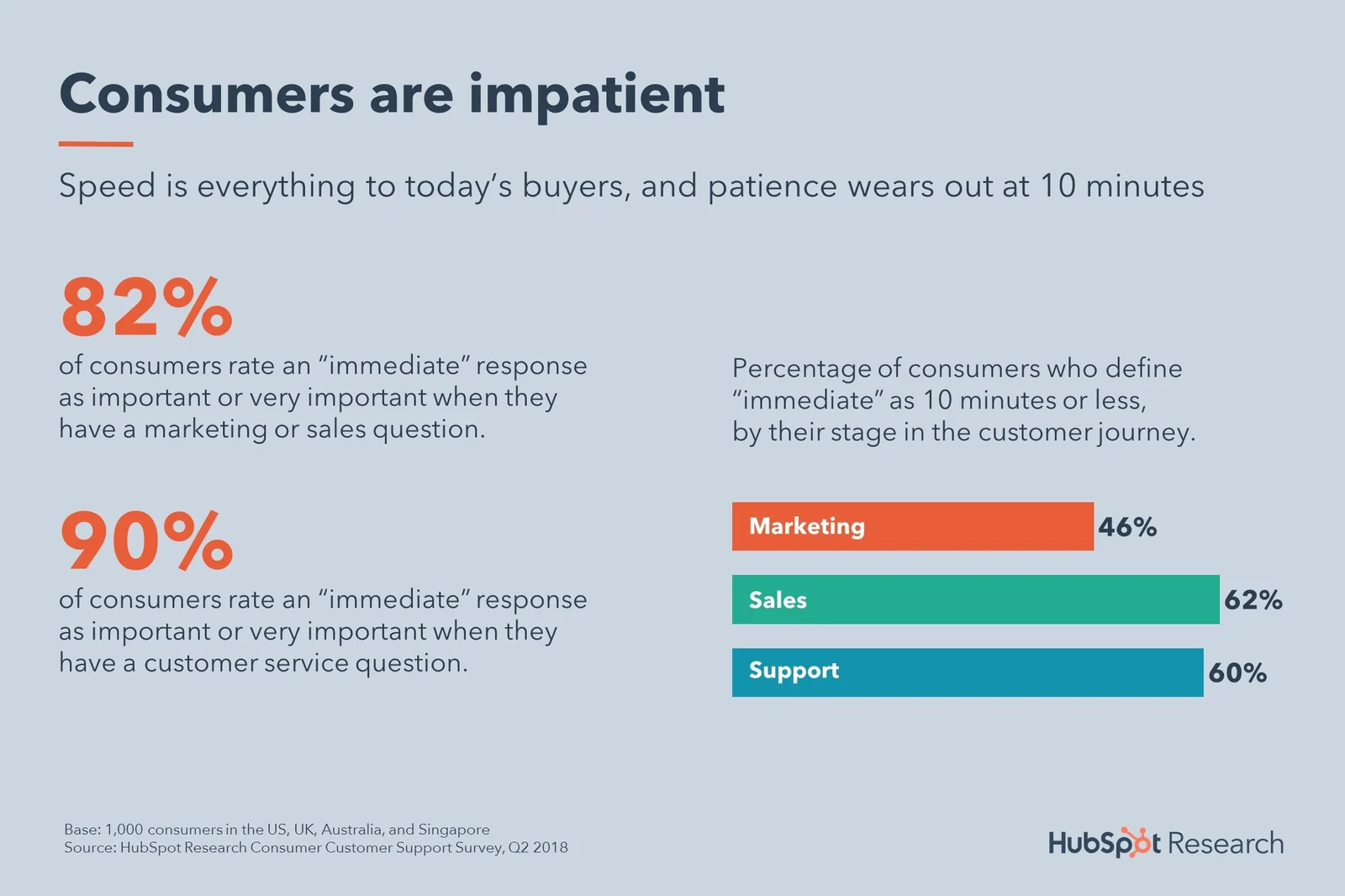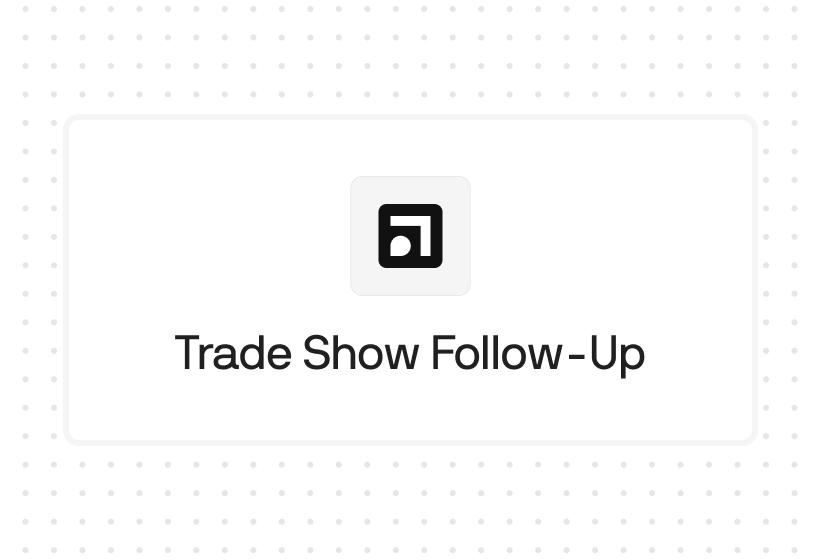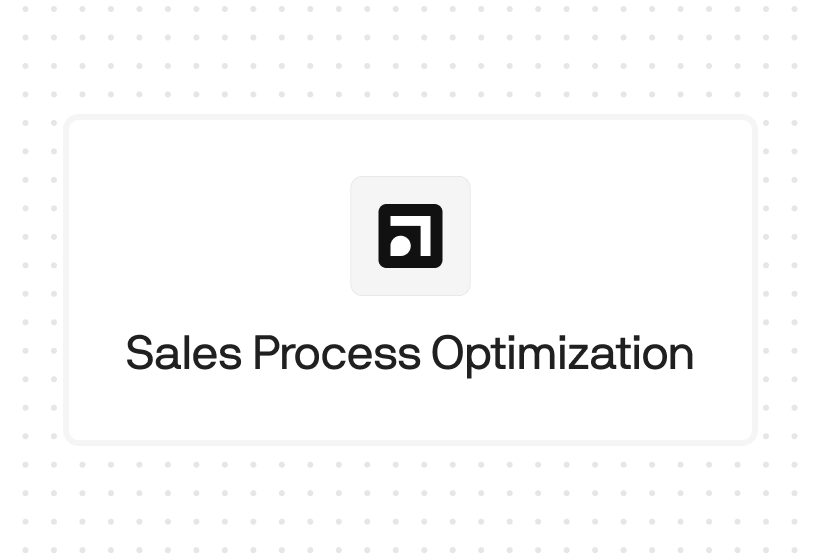Try Default

See how revenue teams automate revenue operations with Default.

Key Takeaways
- B2B conversion rate optimization (CRO) is the process of improving how efficiently your funnel turns traffic into qualified revenue — not just leads.
- The biggest CRO gains come from fixing operational bottlenecks: routing delays, unclear handoffs, and weak qualification, not just landing pages.
- Track stage-by-stage conversion efficiency to identify where performance breaks down and align marketing, sales, and RevOps around shared metrics.
- Sustainable CRO depends on automation and visibility — Default gives teams both, turning every conversion improvement into a repeatable system for growth.
Most B2B teams pour budget into ads and content, only to watch visitors drift away before booking a demo or starting a trial. The real growth lever isn’t awareness; it’s conversion.
That’s what B2B conversion rate optimization (CRO) is about: understanding how buyers move through your funnel, spotting what’s slowing them down, and fixing it with precision.
In this guide, we’ll break down how to find your biggest conversion leaks, test what truly drives buyer action, and track performance like a RevOps pro. By the end, you’ll know how to turn qualified traffic into revenue—without spending more to get it.
What is B2B conversion rate optimization?
B2B conversion rate optimization (CRO) is the process of improving how efficiently your website and campaigns turn visitors into qualified leads or booked demos. Unlike B2C CRO, which focuses on impulse actions, B2B CRO refines complex buyer journeys—optimizing forms, CTAs, and landing pages that drive real pipeline outcomes.
The goal is simple: make every interaction move prospects closer to a revenue conversation.
Why B2B CRO matters for sales and marketing teams
CRO is the quiet force behind predictable growth. In B2B, it transforms how teams convert traffic into pipeline and pipeline into revenue. The result: lower CAC, faster deals, and full alignment between marketing and sales.
1. Lower customer acquisition cost (CAC)
Every dollar spent on ads, content, or outbound campaigns has to produce pipeline, not just impressions. CRO focuses on making existing traffic work harder by improving form completion rates, landing page clarity, and user flow friction.
When your conversion rate increases even marginally, CAC drops significantly because your cost per lead decreases without adding spend.
For operations leaders under pressure to “do more with less,” CRO delivers instant efficiency. It turns fixed marketing budgets into scalable pipeline growth and ensures resources are directed toward what truly converts.
2. Faster pipeline velocity
Time kills deals, and friction kills momentum. CRO helps GTM teams identify where prospects stall (whether in forms, follow-ups, or nurture workflows) and eliminates those delays. By streamlining high-intent touchpoints like demo booking and lead routing, qualified buyers reach sales faster.
According to Gartner, 77% of B2B buyers rate their purchase experience as extremely complex or difficult—meaning that every improvement to speed, clarity, and response time has a measurable impact on conversion. When optimized, your funnel doesn’t just capture leads; it accelerates them toward revenue.
3. Stronger sales and marketing alignment
CRO introduces a shared language of performance across teams. Instead of marketing focusing on MQL volume and sales chasing SQL quality, both measure the same conversion stages and work to improve them.
When every campaign and handoff is tracked for conversion efficiency, it becomes clear where alignment is missing and how to fix it.
Research from SiriusDecisions found that aligned teams achieve 24% faster revenue growth over three years compared to those that operate in silos. The result is a unified revenue process where marketing optimizes lead quality, sales gets better-fit opportunities, and RevOps monitors a single conversion framework.
4. Higher ROI from paid and organic channels
The fastest way to improve ROI isn’t adding more budget; it’s converting more of what you already have. CRO boosts the yield of every acquisition source by capturing and converting a higher share of engaged prospects.
Whether it’s optimizing ad landing pages for intent, testing CTAs, or refining funnel copy, each small improvement compounds over time.
The payoff is measurable: higher conversion rates across paid, social, and organic traffic mean more revenue from the same spend. For performance marketers, CRO is the multiplier that turns incremental testing into sustainable profitability.
5. Data-driven growth visibility
Without CRO, funnel performance is a guessing game. With it, teams gain quantifiable insight into each conversion stage, from awareness to closed-won. This transparency lets RevOps diagnose underperforming campaigns early, measure test impact accurately, and allocate budget to proven levers.
Over time, these insights shape more predictable forecasting and cleaner data hygiene. In an environment where growth depends on precision, CRO becomes the feedback loop that drives continuous improvement.
Key stages of the B2B conversion funnel
Every conversion begins long before a form fill. B2B buyers move through a longer, multi-stakeholder journey where decisions hinge on trust, timing, and clarity. Understanding each stage helps you pinpoint where performance gaps appear — and where CRO delivers the biggest return.
1. Awareness
At this stage, prospects discover your brand through search, paid campaigns, or referrals. The goal isn’t just visibility but relevance. CRO here focuses on click-through and engagement: refining messaging, headlines, and value propositions to attract the right traffic, not just more of it.
2. Engagement
Now interest turns into intent signals — time on site, multiple page visits, and content downloads. Optimization efforts center on guiding these users toward measurable next steps. Tactics include clearer CTAs, simplified navigation, and contextual offers that move visitors from curiosity to action.
3. Conversion
This is where efficiency becomes measurable. Prospects fill out forms, request demos, or start trials. CRO work here means optimizing for frictionless completion: shorter forms, prefilled fields, faster load speeds, and trust signals that reduce hesitation. Small UX shifts can double conversion rates in this stage.
4. Retention
Once a lead becomes a customer, conversion work doesn’t stop. CRO extends into onboarding and activation, ensuring users reach value fast. Retention-focused optimization improves adoption flows, in-app guidance, and customer communication, directly influencing renewal and upsell potential.
5. Expansion
The final stage turns satisfaction into advocacy. Consistent engagement, tailored cross-sell offers, and success-driven content convert happy customers into repeat revenue. This is where CRO supports the full RevOps cycle, proving that optimization isn’t about one-off wins but compounding growth across the funnel.

Proven B2B conversion optimization strategies
Conversion optimization in B2B isn’t about guessing what might work. It’s about creating a measurable system that improves efficiency at every stage of the funnel. These strategies help teams identify high-impact opportunities, fix friction fast, and build a predictable pipeline engine.
Map and measure conversion efficiency across the funnel
Start by instrumenting every stage with conversion metrics — visitor-to-lead, MQL-to-SQL, SQL-to-opportunity, and so on. A clear baseline reveals where drop-offs occur and which improvements deliver the greatest ROI. Without this data, optimization is just speculation. The strongest CRO programs treat conversion tracking as an operational system, not a one-off analysis.
Prioritize high-intent traffic and segmentation
Not all traffic deserves equal attention. Focus CRO efforts on audiences already demonstrating buying intent: visitors engaging with pricing, demo, or comparison pages. Segment by behavior and source to personalize offers and messaging. Optimizing these high-intent segments drives measurable efficiency gains and ensures marketing spend supports sales-ready demand.
Shorten and simplify conversion paths
Complexity kills conversions. Minimize form fields, remove unnecessary clicks, and ensure your CTAs lead directly to the next logical step in the buyer journey. Streamlined flows reduce decision fatigue and keep prospects moving. Every redundant field or slow load time adds friction that compounds into lost pipeline.
Automate lead routing and response workflows
Speed is the single biggest driver of conversion. Default’s own analysis of more than 88,000 inbound leads found that integrating scheduling with web forms improved speed-to-lead by 240×, reducing average response time from 48 minutes to just 2. Automating contact and account creation also shortened qualification by 12 minutes per lead. When lead routing and response happen automatically, your reps engage faster, win more, and never lose a deal to delay.

Use data enrichment to improve qualification accuracy
Leads convert faster when sales has full context. Enrich lead data with firmographic and intent signals to improve scoring and routing accuracy. The better your team understands each account’s potential, the smarter your follow-up strategy becomes. Precision at this stage reduces wasted outreach and increases close rates downstream.
Run structured A/B and multivariate testing
Optimization without experimentation is guesswork. Build a culture of testing with clear hypotheses, measurable KPIs, and controlled timeframes. Prioritize high-impact variables like value propositions, headline clarity, or form design. Regular testing compounds over time, revealing which messages and layouts drive consistent, scalable conversion gains.
Optimize post-conversion experiences to retain and expand
The funnel doesn’t end at the demo or signup. CRO extends into onboarding, activation, and customer success. Analyze where new customers drop off after conversion and remove barriers to adoption. Smooth onboarding and proactive communication turn early users into advocates, improving retention and expansion metrics across the board.
Effective CRO aligns every touchpoint, team, and process around conversion efficiency. When sales, marketing, and RevOps collaborate to remove friction, the result is measurable growth that compounds quarter after quarter.
Metrics to track in B2B CRO
You can’t optimize what you don’t measure. CRO success in B2B depends on tracking both stage efficiency and speed-to-conversion across the funnel.
Start with macro metrics that reflect revenue outcomes:
- Visitor-to-lead rate (top-of-funnel efficiency)
- MQL-to-SQL rate (qualification accuracy)
- SQL-to-opportunity rate (handoff quality)
- Opportunity-to-close rate (sales performance linkage)
Then add micro metrics that reveal friction and velocity:
- Form completion rate and page load time to gauge UX impact
- Speed-to-lead and response time to track how fast sales engages new leads
- Pipeline velocity to measure overall throughput
Together, these KPI metrics create a closed-loop view of CRO effectiveness. High-performing teams don’t just look at conversion percentages; they track how quickly and consistently leads progress toward revenue.
Common B2B CRO mistakes that kill conversions
Every funnel has leaks. The challenge is knowing which ones matter most. These are the conversion gaps that most B2B teams overlook — and the practical fixes that restore consistency, speed, and control.
1. Treating CRO as a marketing project, not a revenue system
When optimization lives only in marketing, the impact stops at the form fill. True CRO spans the entire journey — from first touch to closed-won. RevOps must own the process end-to-end, aligning web, sales, and success teams around shared funnel metrics.
Pro Tip: Rebuild your dashboards to show conversion efficiency by stage, not by channel. This shifts CRO from “traffic tuning” to “revenue performance.”
2. Fixating on vanity metrics
Click-throughs, impressions, and MQL volume rarely predict revenue. Teams often chase surface-level improvements that look good in reports but do nothing for conversion velocity. The most advanced operators measure how fast qualified leads become opportunities, not how many filled a form.
Pro Tip: Replace MQL targets with conversion-to-opportunity goals. It’s the only metric both marketing and sales can influence together.
3. Ignoring lead response time
Most funnels lose qualified leads in the first few minutes after form submission. A delayed response doesn’t just slow conversion; it signals disorganization. When follow-up speed is inconsistent, marketing’s effort goes to waste, and sales loses control of the buyer’s attention.
Pro Tip: Audit your inbound process end-to-end. Track how long it takes for a real sales touch after form submission. Then automate routing and scheduling to make immediate engagement the default, not the exception.
4. Overcomplicating the buyer journey
Many funnels collapse under their own weight — too many steps, fields, or tools. The result? Lost intent. Prospects don’t drop because they’re unqualified; they drop because it’s hard to say yes.
Pro Tip: Run a “conversion friction test.” Have three non-marketers try to book a demo or download a resource. If they hesitate, your funnel’s too complex.
5. Neglecting post-conversion optimization
Teams often celebrate a form fill as the finish line, but it’s only halftime. Leads leak post-conversion when onboarding is slow, communication breaks down, or activation paths are unclear. CRO that ignores retention and expansion leaves long-term revenue on the table.
Pro Tip: Track time-to-value the same way you track speed-to-lead. Both define how efficiently your funnel turns attention into outcomes.
CRO only delivers when the discipline runs deeper than the dashboard. The teams that win are the ones that keep improving small, unglamorous details — routing speed, handoff timing, form friction — until conversion becomes consistent and predictable.
Scale your B2B conversion rate optimization with Default
Optimizing conversions is only sustainable when it’s automated. Default gives RevOps and marketing teams the visibility, speed, and data hygiene to scale CRO across every stage of the funnel. From instant lead routing to automated enrichment and deduplication, Default turns fragmented sales workflows into a single, predictable system for growth.
Ready to make CRO measurable, repeatable, and built into your revenue engine?
Conclusion

Former pro Olympic athlete turned growth marketer! Previously worked at Chili Piper and co-founded my own company before joining Default two years ago.
Accelerate your growth with Default.
Revamp inbound with easier routing, actionable intent, and faster scheduling















.png)








%201.svg)



.svg)





%201.svg)



%201.svg)

